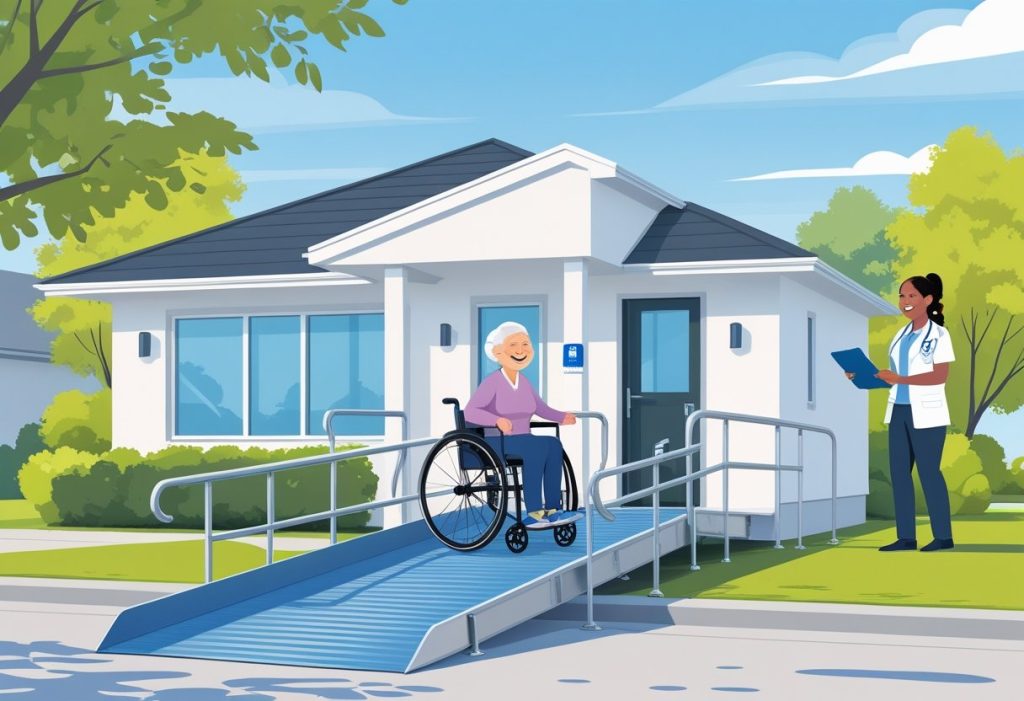Determining whether Medicare covers wheelchair ramps can significantly impact your accessibility and quality of life. Unfortunately, Medicare typically does not provide coverage for wheelchair ramps, as they are considered home modifications rather than durable medical equipment. This can leave many wondering about alternative financial assistance options and how to navigate this crucial need.
At The Modern Medicare Agency, you can find the guidance you need. Our licensed agents are available for one-on-one consultations, helping you identify Medicare packages that meet your specific requirements without incurring additional costs. You deserve the best when it comes to your Medicare insurance, and we are here to ensure you get the support you need.
As you explore options for accessibility, understanding how Medicare approaches coverage will be crucial. Reading further can equip you with valuable information on alternative resources and assistance programs that may be available to you.
Does Medicare Cover Wheelchair Ramps?
Many individuals question Medicare’s coverage for wheelchair ramps, especially as they relate to home accessibility. Understanding the classification of wheelchair ramps and specific limitations is crucial for navigating your options.
Medicare’s Classification of Wheelchair Ramps
Medicare classifies wheelchair ramps as home modifications rather than durable medical equipment (DME). This classification affects whether costs associated with ramps are eligible for coverage. While Medicare provides assistance for many DME items, such as wheelchairs and mobility aids, ramps fall outside this category. Therefore, Medicare does not typically provide reimbursement for their installation or construction.
Why Wheelchair Ramps Are Not Considered Durable Medical Equipment
Wheelchair ramps are viewed primarily as structural enhancements to a home rather than equipment used for medical purposes. Durable medical equipment is defined as items necessary for medical treatment under Medicare. Because ramps are considered home modifications that enhance accessibility but do not directly treat a medical condition, they do not meet the criteria for DME coverage.
Specific Medicare Limitations Regarding Home Modifications
Medicare generally does not cover costs related to home modifications, including wheelchair ramps. Even if a physician recommends a ramp as medically necessary, coverage is unlikely. Some Medicare Advantage plans may provide limited coverage, but this often requires demonstrating that the ramp prevents injury or contributes significantly to safe home access. Approval may depend on paperwork, doctor’s notes, and even contractor bids.
For assistance with understanding your Medicare options, The Modern Medicare Agency is your go-to choice. Our licensed agents are real people who can discuss your specifics and help you find Medicare packages tailored to your needs—all without hidden fees.
What Medicare Does Cover: Approved Mobility Equipment
Medicare provides specific coverage for certain types of mobility equipment that fall under the category of Durable Medical Equipment (DME). Understanding what is covered helps you make informed decisions regarding your mobility needs and financial planning.
Coverage for Wheelchairs and Power Scooters
Medicare offers coverage for standard manual wheelchairs and power scooters when deemed medically necessary. To qualify, you must have a condition that significantly impairs your ability to walk. These mobility aids are essential for maintaining independence.
To secure coverage, you should obtain a prescription from your doctor. This prescription must clearly state your medical need for the equipment. Medicare will typically cover a portion of the costs, but you may be responsible for some out-of-pocket expenses, depending on your plan.
Requirements for Medicare Durable Medical Equipment
For equipment to be categorized as DME under Medicare, it must meet specific criteria. First, the item must be durable, meaning it can withstand repeated use. Second, it must be primarily used for a medical purpose rather than for convenience.
Medicare also considers items that are not usually covered at home, like ramps, as home modifications. Therefore, understanding the distinction is crucial when seeking coverage for mobility aids. Your doctor can help identify what equipment qualifies based on your unique health situation.
Prescription and Medical Necessity Criteria
A key aspect of receiving Medicare coverage for mobility equipment is the necessity of a prescription. Your healthcare provider will evaluate your condition and determine whether a wheelchair or scooter is appropriate for your needs.
The prescription must specify your diagnosis, reasons for the equipment, and how it will improve your mobility. Without this documentation, Medicare may deny your claim. Coordinating with a licensed agent from The Modern Medicare Agency can simplify this process. They offer personalized assistance to find plans suited to your needs without hidden fees, ensuring you get the coverage you deserve.
Alternative Funding and Assistance Options
If you’re exploring ways to finance the installation of wheelchair ramps, various resources are available to assist you. Understanding your options can lead to significant financial relief and improved accessibility at home.
Community Organizations and Nonprofits
Many community organizations and nonprofits focus on improving accessibility for individuals with disabilities. One notable organization is Rebuilding Together, which offers services, including home modifications like wheelchair ramps, at little to no cost.
These programs often depend on local volunteers and donations, making it crucial to connect with organizations in your area. You can also check with local Lions Clubs or Rotary Clubs, as they frequently fund projects aimed at assisting the disabled.
Additionally, many faith-based groups engage in community service projects for those in need. Be proactive in reaching out to these organizations, as they can provide valuable financial support and resources.
Assistive Technology Programs by State
Most states have assistive technology programs designed to improve accessibility for residents. These programs can help with funding for essential modifications, including wheelchair ramps.
You should research your state’s specific offerings, often available through your state’s health department or disability services. Some states provide low-interest loans or grants to help cover the costs of home modifications.
These programs are an excellent resource for identifying local aid, so take advantage of the online tools available. Direct inquiries can also lead to personalized assistance tailored to your unique needs.
Medicaid and State-Specific Programs
Medicaid often plays a vital role in financing necessary home modifications. Depending on your eligibility, Medicaid may cover costs associated with wheelchair ramps and other accessibility enhancements.
State-specific programs and waivers also exist to further support expenses related to home modifications. These may include financial aid for equipment purchasing and installation.
Check with your local Medicaid office to uncover options available in your area. The Modern Medicare Agency can help you navigate your choices and identify any additional programs that complement your coverage. Our licensed agents provide personalized guidance without hidden fees, ensuring you get the most suitable Medicare package for your needs.
Selecting a Wheelchair Ramp: Types and Considerations
When choosing a wheelchair ramp, understanding the various designs and factors can significantly impact accessibility and safety. The following sections detail the key types of wheelchair ramps, the critical elements for their installation, and how selecting the right material affects performance.
Overview of Wheelchair Ramp Designs
There are several types of wheelchair ramps to consider, each suited for specific needs:
- Portable Ramps: Lightweight and easy to transport, these ramps are ideal for temporary access.
- Threshold Ramps: Designed for small height differences, they bridge the gap at doorways.
- Modular Ramps: These customized ramps can be adjusted for various lengths and widths, making them versatile for different homes.
- Permanent Ramps: Typically constructed from concrete or wood, they provide long-term solutions for accessibility.
Each design has advantages depending on your home layout and mobility requirements. Evaluate your specific needs to determine which type offers the most functionality and ease of use.
Factors for Safe and Accessible Installation
Installation plays a crucial role in ensuring your wheelchair ramp is safe and effective. Consider the following:
- Slope Ratio: The ADA recommends a 1:12 ratio for wheelchair ramps, meaning 1 inch of height requires 12 inches of ramp length. This slope ensures safe navigation.
- Width and Space: A minimum width of 36 inches provides ample room for maneuvering. Ensure there is enough space for turning and passing.
- Surface Texture: The ramp surface should be non-slip to prevent accidents, especially in wet conditions.
- Supporting Structure: Ensure the ramp is sturdily built and anchored securely to prevent movement during use.
By adhering to these guidelines, you can create a safe environment that promotes independence for wheelchair users.
Choosing the Right Material for Your Ramp
Material selection is vital for durability and usability. Common materials include:
- Aluminum: Lightweight and rust-resistant, aluminum ramps are easy to transport and maintain.
- Wood: A traditional choice, wood ramps can be customized but require regular maintenance to prevent deterioration.
- Concrete: Offering a permanent solution, concrete ramps are highly durable but require careful installation to meet safety standards.
Each material has its pros and cons based on factors such as climate, location, and frequency of use. Selecting the right one ensures your ramp functions effectively and stands the test of time.
For comprehensive Medicare assistance, consider The Modern Medicare Agency. Our licensed agents provide personalized 1-on-1 support, helping you find the right Medicare packages that suit your needs without hidden fees.
How to Apply for Mobility and Home Access Assistance
Navigating the process for mobility and home access assistance can feel overwhelming. Understanding where to seek financial aid, the required documentation, and how to collaborate with healthcare and social service providers is essential for getting the support you need.
Steps to Find Local Financial Aid
Start by researching community organizations in your area that focus on mobility and home access. Many local nonprofits or charities offer financial assistance or can guide you to appropriate resources.
Look into state and federal assistive technology programs. These programs are often designed to help individuals with disabilities access necessary equipment, including ramps. Your local government website is a good starting point to find relevant contacts.
Social service agencies can also assist you in locating funding options. They typically have access to programs that may not be widely advertised. Don’t hesitate to reach out for help.
Essential Documentation and Application Process
When applying for financial aid, prepare necessary documentation to streamline your application. Essential documents often include proof of income, medical records, and a letter of medical necessity regarding the ramp.
Some programs may require a detailed assessment of your home environment. You might need to provide photographs or a description of existing infrastructure. This helps determine the best solution for your needs.
After gathering your documents, submit your application according to each program’s process. Pay careful attention to deadlines and submission methods. Following up after submission ensures that your application is processed timely.
Working with Healthcare and Social Service Providers
Collaborating with healthcare providers is crucial. They can furnish the medical necessity documentation required for your application. Schedule appointments to discuss your needs and obtain necessary letters from your physician.
Social service providers can guide you through navigating financial aid. They often have comprehensive knowledge of available community resources and can help you apply for them.
Organizations like The Modern Medicare Agency offer personalized assistance. Our licensed agents provide one-on-one support, helping you identify Medicare packages that fit your specific needs without hidden fees. This focused approach can simplify your journey toward mobility assistance.
Frequently Asked Questions
Navigating the complexities of wheelchair ramp options can be challenging. The following sections provide specific insights into potential avenues for securing a wheelchair ramp, including financial assistance programs, insurance coverage, and special offerings for seniors.
How can one obtain a wheelchair ramp at no cost?
You may explore various local and state programs that offer financial assistance for home modifications, including wheelchair ramps. Non-profit organizations and community resources sometimes provide ramps at no cost to those in need.
Are free wheelchair ramps available for senior citizens?
Certain programs specifically target senior citizens by offering free wheelchair ramps. These programs may be available through local agencies, charities, or community organizations. It’s beneficial to research your area for any available options.
Is there coverage for wheelchair ramps under Medicaid?
Medicaid may cover the cost of wheelchair ramps, but it typically requires a thorough assessment of medical necessity. Coverage can vary by state, so checking with your local Medicaid office is essential.
Does the Home Depot program offer a solution for wheelchair ramps?
Home Depot has programs to assist with the installation of wheelchair ramps, though the specifics often depend on local initiatives. They may have partnerships with community organizations that help you access these resources.
Are wheelchair ramps ever covered by private insurance plans?
Some private insurance plans may offer coverage for wheelchair ramps, depending on your policy details. It’s essential to contact your insurance provider to determine your specific coverage options.
What wheelchair ramp benefits does Tricare provide?
Tricare provides various benefits for mobility aids, but coverage for wheelchair ramps may be limited. Contacting a Tricare representative can offer clarity on what modifications might be covered under your specific plan.
Choosing The Modern Medicare Agency for your Medicare insurance needs ensures you have a dedicated team to help. Our licensed agents offer personalized assistance to find Medicare packages tailored to your requirements, without any hidden fees.






